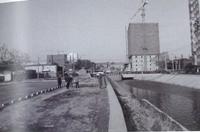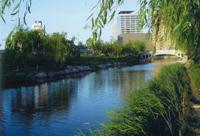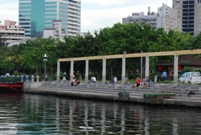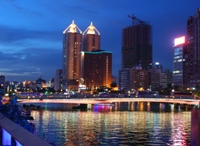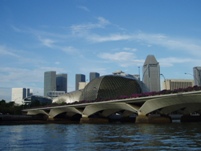
< World's WATERFRONT:WORLD Category: Restoration Project >
|
Before restoration
|
|
After Restoration
|
Zhuanhe River flowing through Beijing was once an important river preventing flooding and supplying water to the outer moat around Beijing Castle. However, during the 1975-to-1982 period, land was reclaimed from the river along with urbanization and many factories and houses were constructed in the reclaimed area. Along with the growing importance of the waterfront environment in the city, however, the City of Beijing started a project to restore Zhuanhe River to its original state in May 2002.
One of the big features of this project is Beijing’s unprecedented awareness of river conservancy, and the project was conducted under the principle of “human-oriented river development to seek harmony and coexistence with nature.” On the premise that river functions are achieved to connect local history and city life organically, this project provides six landscape areas comprising a historical cultural area, ecological park, stone-arranged water scene, waterfront corridor, water garden, and green water channel, without damaging the ecosystem.
By JRRN-secre | Category: Restoration Project,China | Comment(0) | Trackback(0) |
Date: 2009.01.05 16:06
Kaohsiung City is the second-largest city in Taiwan. It has the 3rd-largest container port behind Hong Kong and Singapore, playing a role as the ocean entrance of Taiwan. It is a lagoon city representing Taiwan, which has been developed from the center of the waterfront to the periphery with the concept of “sea city” or “waterside castle city.”
In the past, people turned their backs on “Love River,” which flows through Kaohsiung, due to water pollution and the bad smell. But in about 1985, a water contamination countermeasure plan was drawn up. Since then, water quality improvement projects including sewer work have been conducted. Today, there are walking trails provided along the water, roadside trees planted along the water, and pleasure ships operated. It is the symbol of regeneration of Kaohsiung.
>>More details, “Workshop on Urban River Restoration, Love River in Kaohsiung, Taiwan”
By JRRN-secre | Category: Restoration Project,Taiwan | Comment(0) | Trackback(0) |
Date: 2009.01.05 16:04
Along the midstream and downstream of Yangtze River, the number of lakes connected to the river drastically decreased from a hundred to three. As a result, the lakes’ ecology was badly destroyed, and their flood prevention and water storage abilities were quite damaged. In 1998, Yangtze River experienced the secondly largest flood after 1954. As post-disaster measures, total measures including constructing hydraulic systems, preventing epidemic, rebuilding housing areas, restoring ecosystem, and appealing for international cooperation, are decided as the nation and are now in operation. Nature restoration has been underway, focusing on wetlands.
>>More details (PDF 33KB)
By JRRN-secre | Category: Restoration Project,China | Comment(0) | Trackback(0) |
Date: 2008.03.31 19:45
Gyon-an River restoration project was started with the idea that the best river ecosystem is the one in harmony with the sound recreation and cultural activities. The project aims at restoring and maintaining the natural functions of the Gyon-an River’s ecosystem for a better life and global environment, and at realizing a clean innate river culture.
The basic principal adopted to realize the above is the ecological approach. The project is the first approach in Korea in that it keeps the natural shape to the maximum, and it is a steppingstone to restoring the river course and the basin‘s wetland.
By JRRN-secre | Category: Restoration Project,Korea | Comment(0) | Trackback(0) |
Date: 2008.03.31 19:44
River straitening and drainage development for preparing farmlands started in the late 19th century. By 1968, 95 % of the river was modified and 4000-ha farmland was transformed to cultivated field. But its effects on the environment and the restoration plan were investigated for twelve years, and based on the results, the interested parties negotiated to reach an agreement. In June of 1999, the biggest restoration works in the north Europe started, with the budget of 35 million dollars. It included land acquisition, as well as projects regarding soil, water, and roads, and was called “Skjern River restoration project.”
>>More details (PDF 32KB)
By JRRN-secre | Category: Restoration Project,Europe | Comment(0) | Trackback(0) |
Date: 2008.03.31 19:43
Urbanization caused the pollution of Singapore River whose water became dark and unclean. In order to revitalize the river, strict measures were taken including pig farming prohibition in the area, and moving roadside food vendors, who had discharged wastewater, into buildings.
Singapore imports the half of its water from rapidly-growing Johor Bahru in the neighbor country Malaysia. The country has been eagerly working on: water development using domestic catchment; recycling sewage; and importing water from multiple sources.
>>More details (PDF 38KB)
By JRRN-secre | Category: Restoration Project,Other Asina Countries | Comment(0) | Trackback(0) |
Date: 2008.03.31 19:42
The San Francisco Bay area consists of nine counties, with the population of 650 million and the dimension of 19400 km2. Each county has its own land use plan. Around thirty years ago, the San Francisco Bay Conservation and Development Commission (BCDC) was established by the residents who were concerned about the waterfront reclamation by the rate of 10 km2 every year. Based on the annual budget of four billion dollars, BCDC has been granted with the wide-ranging powers of making various political decisions as an agency, including the power to protect the existing port, the power to build recreation facilities for the citizens, and the power on the airport and on the wildlife preserve. With the budget of four billion dollars, various projects have been implemented together with the local government, and the local economy has continuously been vitalized. One example is the waterfront restoration program (Calfed Bay Delta Program) in Calfed Bay Delta area where Sacrament and San Joaquin waters flow into the San Francisco Bay. The program promotes environment restoration over more than thirty years, focusing on the fields of drinking water quality and of ecosystem conservation.
>>More details (PDF 40KB)
By JRRN-secre | Category: Restoration Project,North America | Comment(0) | Trackback(0) |
Date: 2008.03.31 19:24
The scenery of Rhine River in Netherlands has dramatically changed by centuries of human activities such as creating banks that decreased anti-flood fields; agricultural use of anti-flood fields; river course improvement for transportation; and massive wastes disposal. It resulted in deterioration of Rhine River’s environment. In 1970s, the aquatic life in the river was contaminated by harmful chemicals, and the river was called “sewage in Europe.”
Especially after 1986’s chemical factory fire in Sandos, Switzerland, the water quality was deteriorated. People grew conscious on environment, and created “Rhine River activity plan” targeting at “salmon living river by 2000.”
By the end of 1980s, thanks to the efforts by the surrounding local governments, the environment was recovered to a level to be quoted as a hygienic excellence.
>>More details (PDF 39KB)
By JRRN-secre | Category: Restoration Project,Europe | Comment(0) | Trackback(0) |
Date: 2008.03.31 19:24
From 1860s, there was a river development in upstream of Rhine (Basel – Bingen) aiming at flood prevention and inland river transportation. In 1930s, river improvements were done for hydraulic power generation and inland river transportation. Treaty of Versailles after the World War I gave France a right on Rhine River, and France established a new channel for river transportation, parallel to Rhine River. As a result of these changes, anti-flood fields were diminished and flood frequented in the upstream region. Given the situation, a comprehensive Rhine River flood control plan was proposed. By restoring and conserving anti-flood fields, Rhine River’s flood control functionality (estimated 270 million m2) is expectedly recovered. Governmental agencies and NGOs operate focusing on water quality improvement, free fish inhabitation and relocation, and habitat variety improvement.
>>More details (PDF 42KB)
By JRRN-secre | Category: Restoration Project,Europe | Comment(0) | Trackback(0) |
Date: 2008.03.31 19:23
Missouri River, a largest and the longest river in North America, has been widely modified over these 150 years.
However, as the American people grew aware of the environmental ethics, they came to focus on the deterioration of the major rivers in the country, and to reexamine the river management priority. As a result, some national laws and state laws were established, and many measures to support restoring a number of major rivers in America were provided. For Missouri River, based on the Missouri River Mitigation Act (an act of compensation for environmental destruction), a project was implemented, which restored the wetland and the riverside forests, changed the banks and weirs, and reunited the “chutes” (water channels for high water) with the mainstream.
>>More details (PDF 33KB)
By JRRN-secre | Category: Restoration Project,North America | Comment(0) | Trackback(0) |
Date: 2008.03.31 19:22
| Next >>
